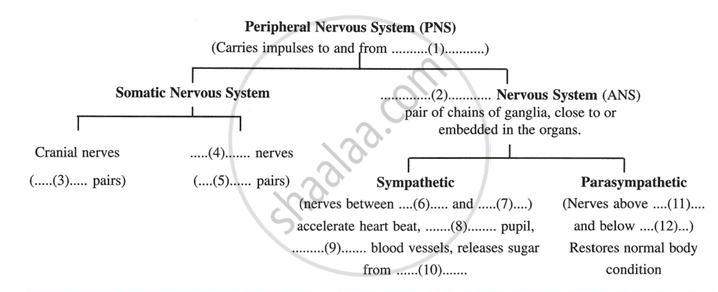Advertisements
Advertisements
Question
The number of cranial and spinal nerves in a human being are respectively ______.
Options
31, 12 pairs
32, 21 pairs
12, 31 pairs
31, 21 pairs
Solution
The number of cranial and spinal nerves in a human being are respectively 12, 31 pairs.
Explanation:
A human being has 12 pairs of cranial nerves and 31 pairs of spinal nerves.
RELATED QUESTIONS
The insulating sheath covering the neural axon is called.
A mixed nerve is one which
what do we refer to in the nervous system when we say:
sensory, motor and mixed ………………..
During a street fight between two individuals, mention the effects on the following organs by the autonomous nervous system, in the table given below : (one has been for you as an example).
| Organ | Sympathetic System | Parasympathetic System |
| e.g. Lungs | Dilates bronchi and bronchioles | Constricts bronchi and bronchioles |
| 1. Heart | ||
| 2. Pupil | ||
| 3. Salivary gland |
Given below are a few situations. What effective change will occur in the organ/body part mentioned and which part (sympathetic or parasympathetic) of the autonomic nervous system brings it about?
| Situation | Organ/body part | Change/action | Part of autonomic nervous system involved |
| 1. You have entered a dark room | Eye | ||
| 2. Your body is consuming lot of glucose while running a race | Liver | ||
| 3. You are chewing a tasty food | Salivary gland | ||
| 4. You are running a race | Adrenal gland | ||
| 5. You are retiring to bed for sleep | Heart | ||
| 6. You are shivering in intense cold | Body hairs |
Given below is the partially incomplete scheme of the components of peripheral nervous system. Fill up the blanks numbered (1)-(12):

Define the following:
Cyton
Write full form of the following abbreviation:
CNS
While watching a scary movie, mention its effects on the following organs by the autonomous nervous system in the table given below: (one has been done for you as an example).
| Organ | Sympathetic System | Parasympathetic System | |
| e.g. Lungs | Dilates bronchi and bronchioles | Constricts bronchi and bronchioles | |
| (1) | Heart | ______ | ______ |
| (2) | Pupil of the eye | ______ | ______ |
| (3) | Salivary gland | ______ | ______ |
Two hungry boys (A and B) enter a restaurant and see the menu. Boy B starts salivating but not A. Explain the reason for this difference.
